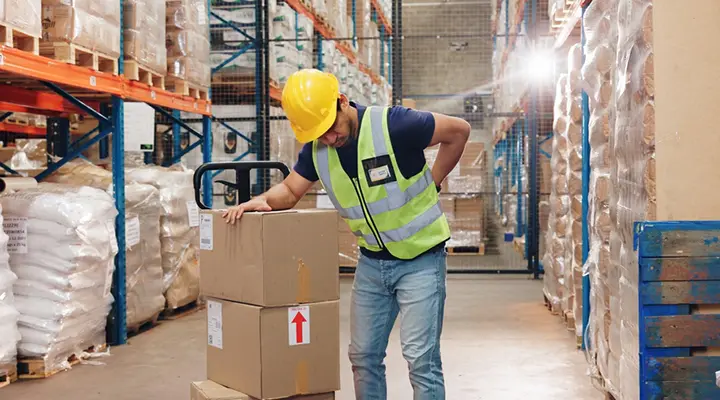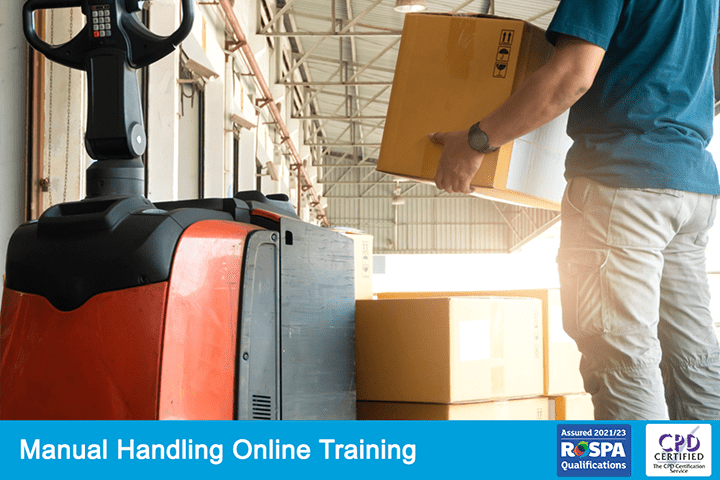Manual handling injuries can occur in any type of workplace. Tasks such as stocking shelves, moving furniture, lifting laundry bags, carrying equipment and tools, lifting a child or helping a person to stand can incur an injury if you do not take precautions.
According to the HSE, handling, lifting or carrying account for almost a quarter of all reported incidents in the workplace. Also, manual handling is the main activity associated with incidents that result in at least 7 days off work. Following safe manual handling practices at work helps to protect employees against injury and improve business productivity.
This article explains manual handling, relevant legislation and 5 key principles of manual handling that help to avoid injury.
What is Manual Handling?
Manual handling is any activity that requires you to transport or support a load by hand or by bodily force. It involves activities such as holding, pushing, pulling, carrying, throwing, putting down and lifting of loads. Some examples of manual handling tasks are lifting boxes, assembling products, pulling or pushing trolleys, packing boxes, lifting heavy equipment and tools, leaning over to scan grocery items or to wash dishes, lifting people or animals.
Our RoSPA-assured manual handling online training course provides learners with the knowledge to reduce the chances of injury whilst manually handling loads in a work environment. Making their workplace a safer environment to work in.
All employers must comply with the Manual Handling Operations Regulations 1992, as amended by the Health and Safety (Miscellaneous Amendments) Regulations 2002. The law requires employers to take reasonable steps to safeguard the health and safety of all employees. Including minimising the risk and raising awareness about the hazards related to manual handling.
What are the risks of Manual Handling?

If your employees carry out manual handling activities, they are highly vulnerable to musculoskeletal injuries and other related disorders.
Incorrect manual handling can incur short term acute injuries or long term chronic disorders. Some examples of short term injuries are small fractures, sprains, tears and muscle strain. They usually occur due to sudden accidents. For example, lifting a heavy load at an awkward angle, losing grip and dropping a load, or tripping over while carrying a load. Long-term injuries involve damage to the musculoskeletal system, including bones, muscles, joints, tendons, ligaments, nerves, and blood vessels. Injuries occur due to long-term wear-and-tear as a result of repetitive manual handling activities. They are known as musculoskeletal disorders (MSDs).
The 5 key principles of manual handling to avoid injury
There are many ways to control manual handling risks. Best practice is to design work processes that minimise or avoid handling, lifting and carrying altogether. However, if you cannot minimise or avoid it, you should follow the 5 key principles of manual handling that help to prevent injury while manually handling loads at work.
- Plan – before lifting ensure that your entire path is clear, there are no obstructions or trip hazards, the floor is even and not slippery. Tripping over or having to put down the object midway are easily avoidable hazards. Also, before you lift a load, ensure that the object is not too heavy or too awkward to grip it properly and move. Ask another team member for help when necessary.
- Position – centre the body and feet correctly. Keep your feet apart with one leg slightly forward for support. Bend your knees and avoid bending the back and leaning forward as it increases the stress on the lower back. Then get a good and secure grip.
- Pick – as you move the object upward, use your leg muscles to lift it. Keep it close to your body, maintain a smooth and natural motion and avoid any sudden movements.
- Proceed – as you carry the object, keep the load close to your body. Support the load with your arms, keep your head and spine upright and avoid twisting, bending or reaching.
- Place – as you lower the object, keep a good posture. Bend your knees and use leg muscles. Then position the object securely and use a smooth, steady motion to release the grip. Do not drop a heavy load or jerk it around.
Pushing and pulling
Pushing and pulling also falls under manual handling activities. This avoids lifting and carrying of objects. However, you should still take precautions while pushing and pulling a load to avoid injury.
Pushing and pulling activities involve sliding, rolling, or moving an object on wheels. While pushing and pulling a load, you must keep a good posture, keep your feet well away from the load and go at a usual walking speed. The handle should be between waist and shoulder height. Also, you should ensure that you do not overload the handling equipment and that it is not too heavy. Any slopes, ramps or uneven floors require higher forces, so you should ask for help when necessary. Furthermore, you must ensure that there are no tripping hazards on the route and the handling equipment is in good working order.
Manual Handling legislation
Employers have a legal duty to protect their employees against the risks associated with manual handling at work.
The Health and Safety at Work Act 1974 requires employers to protect the health and safety of their employees and anyone who might be affected by what they do. In turn, employees must cooperate with health and safety guidelines so that the employer can comply with the law.
Manual Handling Operations Regulations 1992 set out specific duties for employers and employees with regard to manual handling. The regulations provide guidance on how to avoid, assess and reduce the risk of injury from manual handling.
According to the Manual Handling Operations Regulations 1992, employers must take relevant measures to deal with manual handling risks. These are:
- Avoid any hazardous manual handling activities as far as it is reasonably practical.
- Assess any hazardous manual handling operations if it cannot be avoided.
- Reduce the risk of injury as far as it is reasonably practical.
Under the Manual Handling Operations Regulations 1992, employees must take reasonable care to protect their own health and safety and that of others who may be affected by their actions. General employees’ duties include:
- Follow proper work systems laid down by their employer.
- Use relevant work equipment provided for their safety.
- Co-operate with their employer on health and safety matters.
- Inform the employer about any hazardous handling activities they have identified.
- Take reasonable care to ensure that their actions do not put themselves or others at risk of injury.
How to ensure safe Manual Handling at work
- Assess the risks. Carry out a regular manual handling risk assessment to identify the risks of hazardous manual handling in a workplace. Then, decide what actions you will take to reduce those risks. Pay particular attention to individuals who may be especially at risk – people with disabilities, pregnant women, inexperienced workers or people returning to work after a recent manual handling injury. Also, consider psychological risk factors, which may lead to an increased risk of injury when moving or handling a load.
- Avoid hazardous manual handling. Eliminate hazardous manual handling by not moving loads if a task can be done in an alternative way. If handling cannot be eliminated, consider using handling equipment or mechanical aids to reduce the risks.
- Involve your employees. Workers who carry out manual handling activities know first-hand about the risks in the workplace and can suggest practical solutions to control or eliminate them.
- Inform and train your employees, so that they are aware of manual handling risks and understand safe work practices to avoid manual handling injury at work.
Need Manual Handling awareness training?
We offer the following RoSPA-assured and CPD-certified online Health and Safety training courses :




